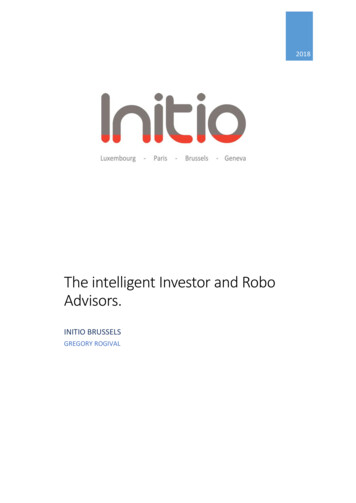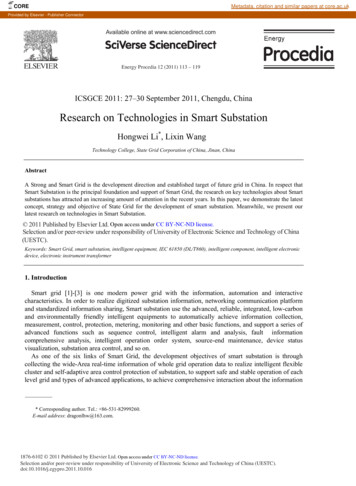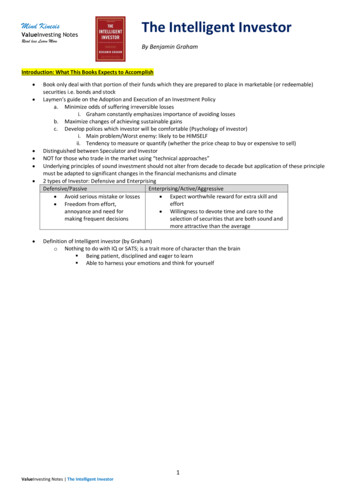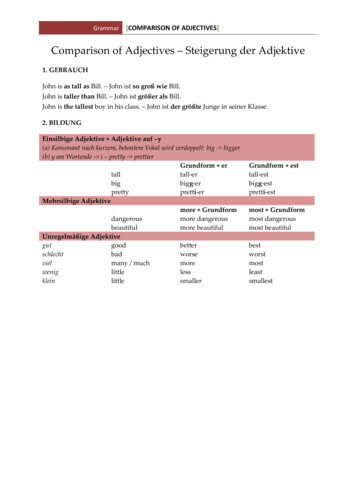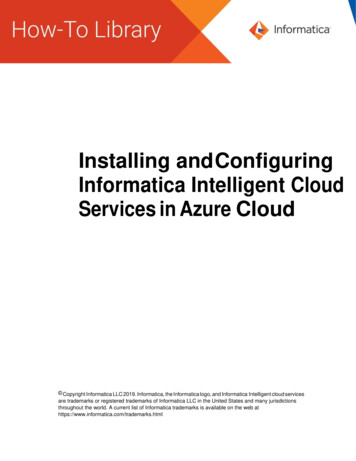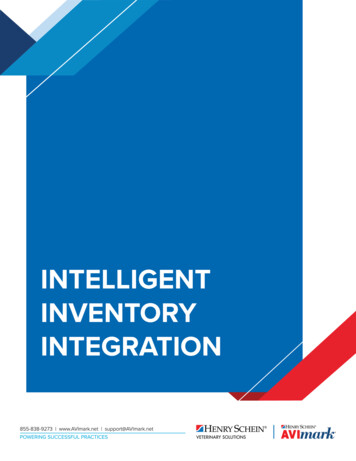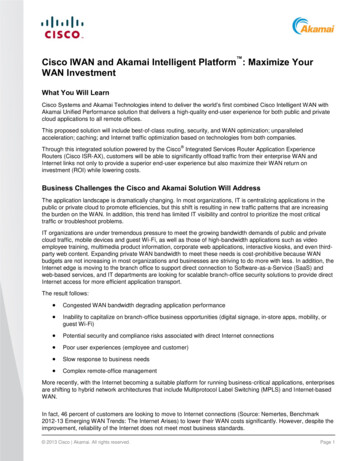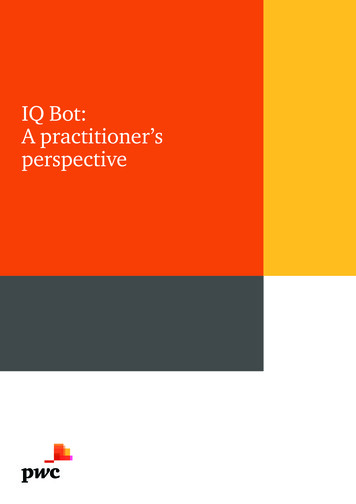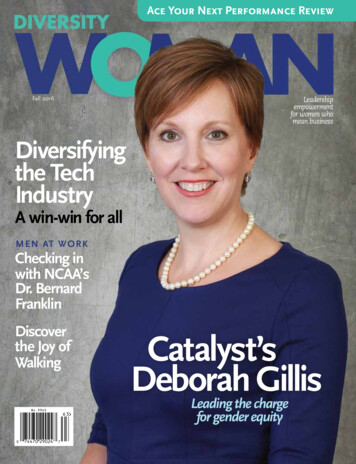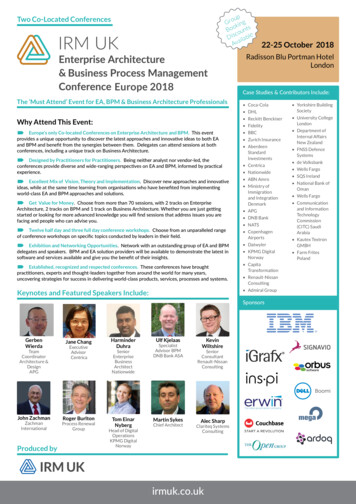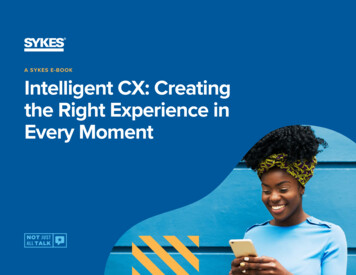
Transcription
A SYKES E-BOOKIntelligent CX: Creatingthe Right Experience inEvery Moment
ContentsIntroduction03A Cycle of Disruption and Evolution03Intelligent CX — Beyond Omnichannel04Chapter One: The SYKES Approach to Intelligent CX05Start With a Foundation of Data07Focus on Reducing Effort10Chapter Two: Intelligent CX Step-by-Step13Map the Customer Journey14Understand the Customer Objective by Stage16Determine if Personal Interactions are Beneficial16Collect the Outcome Data and Optimize Future Interactions18Chapter Three: The Intelligent CX Workforce19Conclusion22Intelligent CX: Creating the Right Experience in Every Moment2
IntroductionA Cycle of Disruption and EvolutionSince the early days of “Web 2.0,” digital strategies inbusiness have been in a cycle of disruption and evolution.The Internet tore down the old media model of TV, print andradio ads as the sole distribution channels. It gave birth todigital distribution, along with multichannel and omnichannelapproaches to customer experience.With a multichannel approach, brands were eager to gettheir messages out on as many channels as possible as thecustomer journey became less linear. If companies couldn’taccurately predict where customers would engage, theywould blanket as many channels as possible to ensure thatthey would eventually reach that customer.However, maintaining and managing the various channelsbecame too challenging for many organizations to handlein-house, so brands used outside vendors to take on thoseresponsibilities. Forming external partnerships presented aunique set of problems, though, as there was little connectivitybetween vendors. The partnerships achieved brand presence,but not cohesive messaging and experience.As customer expectations became more focused on channelinterconnectivity and higher-quality interactions, multichannelgave way to omnichannel. Omnichannel’s goal was to beeverywhere the customer wanted to be and to connect thevarious brand interactions into a cohesive experience.Omnichannel focused on delighting thecustomer with messaging that felt personaland consistent. It finally delivered theconnection between touchpoints thatmultichannel lacked. However, it was areactive process that relied on post-interactionanalyses — rather than listening to customers.Businesses need a way to proactivelyanticipate customer needs and deliver theright experience for the individual.Intelligent CX: Creating the Right Experience in Every Moment3
Intelligent CX — Beyond OmnichannelOmnichannel is now undergoing the disruption cycle. Newknowledge and technologies usher in the next evolution ofcustomer experience. What emerges is an “omni-digital”approach called “Intelligent CX.” This method focuses more onunderstanding the experience than merely connecting the channels.Intelligent CX strikes a balance between personalization andefficiency. The ultimate goal is to reduce customer effort, whichis a leading factor in building customer loyalty. It relies on data tounderstand the intent of the customer at each touchpoint, journeymapping to find the most effortless path to each touchpoint’s goal,automation to increase efficiency and accuracy, and a properlytrained workforce to provide customers connected, personalizedexperiences at the right moments.In this book, we will explore SYKES’ application of IntelligentCX, and show you how you can use this approach to becomean efficient, experience-led organization and grow unparalleledcustomer loyalty.Intelligent CX: Creating the Right Experience in Every Moment4
Chapter One:The SYKES Approachto Intelligent CX
Chapter One: The SYKES Approach to Intelligent CXSYKES’ purpose-driven strategy of “helping people, onecaring interaction at a time” has enabled the organization tobecome an industry leader in providing the highest-qualitycustomer interactions. With highly-evolved and rapidlyshifting customer expectations, SYKES stays ahead of theconsumer trends curve to continue delivering compassionateengagements on behalf of its brand partners.SYKES’ new approach focuses on understanding andrespecting the needs of the customer and providing themwith an experience that exceeds their expectations. Thisunderstanding could mean deep and engaging interactionswith live agents. It could mean agent-free online sales orsupport experiences. It could also mean respecting thecustomer’s time and using automation and other digital tools toreduce the number of interactions to a minimum.With the goal of understanding andtailoring experiences for diversecustomer needs, SYKES has made aseries of strategic acquisitions andinvestments over the past 10 years.These include: Alpine Access (2012): Pioneer in home-basedcustomer care TalentSprout (2012): Expert in learning and talentdevelopment services Qelp (2015): Innovator of digital self-service softwareand content optimization Clearlink (2016): Leader in digital marketing andsales, specializing in data science, personalizedonline experiences and customer acquisition XSELL Technologies (2017): Visionary of machinelearning platforms to p rovide sales agents withreal-time support Symphony Ventures (2018): Trailblazer of roboticprocess automation and other digital operationsthrough global consulting, implementation andmanaged serviceIntelligent CX: Creating the Right Experience in Every Moment6
By intentionally combining and leveraging the expertise of these companies,alongside SYKES’ foundational customer experience-center capabilities, theSYKES family of brands provides the people, technology and data needed toapply an Intelligent CX process to any or all parts of the customer journey.In the SYKES customer journey, digital marketing, sales, support and customerretention are augmented with automation at appropriate points for increasedspeed and accuracy. By bringing these capabilities under one umbrella, iteliminates silos that often exist between various business units. The holisticapproach to the customer journey allows the journey itself to take centerstage, rather than the touchpoints.We’ll breakdown how this process works in practice in a bit; but first, it’snecessary to lay the foundation on which Intelligent CX builds: data.Start With a Foundation of DataAs previously mentioned, the issue with a multichannel approach is thatadding channels increases opportunities for inconsistencies across voice,messaging and experience delivery. While experience scores for individualtouchpoints may be strong, ratings for the complete journey can suffer. Anexperience-led organization focuses on the connections between touchpointsto deliver the most effortless journey for the customer. Creating thoseconnections and streamlining experiences requires accessible data, which iswhere many brands fall short.An experience-ledorganization focuses onthe connections betweentouchpoints to deliver themost effortless journey forthe customer.Intelligent CX: Creating the Right Experience in Every Moment7
Intelligent CX uses an encrypted data repository capable ofingesting data from any internal or external input. This capabilitymeans brand partners can benefit from their own data sources,as well as sources from across the SYKES organization. SYKESuses its suite of CX data management services to collect,connect and contextualize information of a customer’sjourney and predict the best path to the next touchpoint.Accessing the data is achieved through application programminginterfaces (APIs) from applications for each department. Forexample, when routing a customer’s call to a sales agent, theinteractive voice response (IVR) API pings the data repositoryto find information connected to the customer’s phone number.If the customer used that phone number to populate an onlineorder form, it triggers a priority status for the call, showing highintent to purchase. The agent then knows that the customercame from an online shopping cart and knows which product orservice the customer is considering. The call or chat could pickup right where the online experience left off.SYKES has a data advantage over other companies,primarily due to the high volume of customer conversationsthat flow through its customer experience centers. A recentHFS Research report identified this advantage:“ [Companies need to] make the contactcenter the strategic hub of their businessin order to listen better to the voice of thecustomer and cater to their needs.”- Melissa O’Brien, HFS ResearchIntelligent CX: Creating the Right Experience in Every Moment8
SYKES has agents handling millions of calls and chats focused on sales,support and retention every year. Such consumer touchpoints provide firsthand data inputs from which SYKES can identify trends and opportunitiesto improve the customer experience. This includes examining data from thewebsite clickstream, marketing analytics, IVR, call flows, chat logs and postcontact surveys to understand the types of interactions customers prefer.Keeping efficiency at the forefront, SYKES looks at data gathered at eachstage to reduce friction within — and between — them.CASE STUDYSYKES’ End-to-EndSolution Helps aTravel-BookingGiant’s CX SoarWays SYKES’ Data Can Improve the Stages in the Customer Journey: Marketing: Phone and chat data can help identify key customer termsto optimize SEO and PPC. Understanding the features and benefitsrelevant to customers informs campaign messaging effectively.View Case Study Sales: Aggregating data from successful sales interactions helpsidentify replicable patterns for future customers. Comparativeanalyses reveal conversion rates for various packages and products. Support: Frequently asked questions and common issues that arisefrom customer experience-center data can inform and optimizeonline self-service content. Known issues can be passed on to theproduct department for updates and bug fixes. Retention: By understanding implicit and explicit intent signals thatlead to churn, proactive steps can be taken to prevent customerswith a high propensity to cancel from abandoning the brand. Forcustomers coming to the end of a contract, personalized renewaloffers can be created based on what matters most to that customer.Intelligent CX: Creating the Right Experience in Every Moment9
With this solid data foundation in place, SYKES can begin toimplement the Intelligent CX process for its brand partnersacross their various customer-journey touchpoints.Focus on Reducing EffortThe goal of Intelligent CX is to provide the most effortless pathfor customers to complete a task. Personalization still plays arole, but Intelligent CX’s main tenet is that reducing the numberof necessary interactions or keeping to fast interactions is best.This approach contradicts the prevailing omnichanneltheory that customers want to be “wowed” at every turn.While personalization has been shown to improve customersatisfaction (CSAT) and Net Promoter Score (NPS ), it does littleto encourage customer loyalty. When it comes to earningcustomers’ business for the long-term, companiesthat reduce customer effort come out on top.Net Promoter, Net Promoter Score and NPS are registered trademarks of Bain &Company, Inc., Satmetrix Systems, Inc., and Fred Reichheld.Intelligent CX: Creating the Right Experience in Every Moment10
In 2010, the Harvard Business Review unveiled a metric called the CustomerEffort Score (CES), which asked a single 1-10 scale question, “How much effortdid you personally have to put forth to handle your request?”The survey polled 75,000 B2C and B2B customers about recent serviceinteractions across common digital and voice channels, including live phonecalls, voice prompts, web, chat and email. The results revealed two keyfindings: “First, delighting customers doesn’t build loyalty; reducing theireffort — the work they must do to get their problem solved — does. Second,acting deliberately on this insight can help improve customer service, reducecustomer service costs, and decrease customer churn.”Mapping the CES against CSAT and NPS showed a significant improvement inpredicting whether a customer would “keep doing business with the company,increase overall spend or spread positive (and not negative) word of mouth.”“ Delighting customersdoesn’t build loyalty;reducing their effort —the work they must doto get their problemsolved — does.”- Harvard Business ReviewIntelligent CX: Creating the Right Experience in Every Moment11
As of 2018, the preferred method of measuring CES is by asking a singlequestion and scoring the response on a scale from 1 to 7, with 7 being thehighest level of agreement with the statement “The company made it easyfor me to handle my issue.” This is a simplified way to measure effort, but thechange in measurement did not change the results. The book The EffortlessExperience states that, “96% of customers with a high-effort service interaction become more disloyal compared to just 9% who have a low-effort experience. Disloyal customers are likely to cost the company more — they spreadnegative word of mouth and cease future purchases.”“ 96% of customers with a high-effort service interactionbecome more disloyal compared to just 9% who havea low-effort experience. Disloyal customers are likely tocost the company more — they spread negative word ofmouth and cease future purchases.”CASE STUDYSYKES CutsLeading Telecom’sCustomer SupportCalls by 20% WithIntelligent CXView Case Study - The Effortless Experience, Matthew Dixon, Nick Toman and Rick DeLisiWith this in mind, let’s examine how to use the tools at your disposal to beginreducing the effort in your customer interactions.Intelligent CX: Creating the Right Experience in Every Moment12
Chapter Two:Intelligent CXStep-by-Step
Chapter Two: Intelligent CX Step-by-StepTo provide the customer with the most efficient path throughtheir journey, implement Intelligent CX using the followingsteps. Apply them at the macro- and micro-levels, in separatecomponents or — ideally — all together.1. Map the Customer JourneyMapping a customer journey can be a complex exercise, but onethat is vital to gaining a better understanding of how customersare interacting with your brand. Instinct is enticing to trust, butdata won’t lie.Separate the customer journey into stages — e.g., marketing,sales, support or retention — and align them with a commongoal. An Intelligent CX journey map intends to deliver the mosteffortless experience possible, which provides clear direction onrestructuring your touchpoints in each stage.Hubspot has a helpful article for creating a journey map thatprovides a more detailed walkthrough of this process. There areseveral examples based on the type of business you’re in, asjourneys will vary by industry or product.Intelligent CX: Creating the Right Experience in Every Moment14
15Customer Journey Map Example
2. Understand the Customer Objectiveby Stage3. Determine if Personal Interactionsare BeneficialAt each stage of the journey, examine the customer’s goalswithin them. The design thinking method of generating auser story is a useful exercise. User stories can be summarizedby the following statement, “As a (user), I want to do (this) toachieve (that).”Depending on the customer’s objectives identified, ask,“Can the user’s objective be met by not engaging with a liveagent?” If the answer is no, then use data and technologyto make the interaction as personalized and rich in value aspossible. A few examples include:U S E R S T O R Y F O R M AT“ As a (user), I want to do(this) to achieve (that).”Look at the stages identified in the journey map, apply theuser story statement to each stage, then determine the mosteffortless way to achieve that statement. Examine whetherthe user story is to complete a task or to gain a deeperunderstanding through personal interaction.Online-to-Offline Data Passing: Clickstream dataabout the customer’s online experience transfersto the offline world to dynamically change IVRmessaging and agent call flows.Intelligent Call Routing: This routing type uses dataassociated with the customer’s phone number toroute the call to an agent with the highest likelihood ofproviding the best experience.Personalized Offers: The technology uses customerdata — alongside predictive lifetime value estimates— to tailor offers specific to each customer. Thoseoffers are passed to the agent in real-time to givethem the most relevant product information, as wellas a powerful customer acquisition tool.Intelligent CX: Creating the Right Experience in Every Moment16
If the objective can be reached without interaction, examinewhich process can help achieve that goal. Processes can includeutilizing an online ordering system, online self-service content orintelligent automation like chatbots.Some examples of this type of augmentation include:Knowledge Bots: These bots comb through knowledgebases for agents, instantly delivering the answer tocustomer questions.Robotic Desktop Automation (RDA): Intelligent botsperform repetitive data entry tasks for agents, freeingagents to better personalize the experience withoutsacrificing speed or quality.AI-Assisted Chat: Conversation data from pastinteractions is analyzed, aggregated and used to informchatbots. These chatbots follow along with the agent’sconversations and suggest the best responses basedon historical data.Once you reach the objective, it’s time to begin the optimizationprocess.Intelligent CX: Creating the Right Experience in Every Moment17
4. Collect the Outcome Data andOptimize Future InteractionsLaunchLearnBuildITERATION 2LaunchsureeaMBuildsignDeITERATION 1sureeaMsignDeLearnBuildsignDesureeaMIdentify areas for improvement, implement changes andcontinually reexamine. Following this methodology allows theprocess to adapt to customer behavior as it changes.LearnFeedback loop optimization is vital to Intelligent CX. At thisstage, measure the outcome data from the various stagesagainst the user stories developed in Step 2. Did the processaddress the goal of the journey map?ITERATION 3LaunchWith the step-by-step outline in place, let’s look at how using automation can help make your Intelligent CX faster and more accurate.Intelligent CX: Creating the Right Experience in Every Moment18
Chapter Three:The Intelligent CXWorkforce
Chapter Three: The Intelligent CX WorkforceWhen it comes to the people in your workforce, they can bothimplement the Intelligent CX process and benefit from it.On the implementation side, employees must understandthe goals of Intelligent CX. Implementing it also involveshiring people from the onset who see the value in effortlessinteractions from personal experience. It means training themon the inner-workings of the Intelligent CX approach, andgiving them the technology and tools needed to deliver on thepromise of Intelligent CX.SYKES recruits new hires that have well-rounded experience inthe digital customer experience.Internally, there is a priority for cross-departmentalcommunication at SYKES. With the internal teams focused oncreating the most effortless experience throughout the journey,there is a focus to not only solve the problem at hand but alsohead off problems that may arise in the future. Seamlesslypassing data between departments ensures that teams geta holistic picture of what others are doing and can approachproblems with that context in mind.Examples of Questions Teams Ask to Connect theDifferent Stages Include: Marketing-to-Sales: Do visitors of one blog postor landing page convert at a higher rate? Sales-to-Support: Do customers always askthe support team the same question about aparticular product? Marketing-to-Support: Did support inquiries fallright after adding customer-care content? Retention-to-Sales: Do certain products have alower churn rate? Which products are most usefulto offer as incentives for re-enlistment?These questions can lead to changes in processes thatbenefit the customer directly, but when employee effortis reduced, the customer benefits there, too. One ofSYKES’ tech brand partners saw this in action recently.CASE STUDYSYKES Improves Customer& Agent Experience for aMajor Business Tech BrandView Case Study
SYKES has also integrated components of Intelligent CX in brand-advocateprocesses and touchpoints from onboarding through training and operations.Specifically, agents interact with AI that uses conversation data fromthousands of interactions and natural-language processing to create a virtualcustomer. Think Apple’s Siri or Amazon’s Alexa programmed to be a customer.The AI gives the agent a more realistically simulated experience of the realworld customer experience center. The capabilities of this AI-augmentedtraining have reduced the need for roleplaying or live-training scenarios,which are unrealistic and less useful. This approach has seen a 4x increasein speed at which new hires are ready to field real calls with similar or betterresults than traditional classroom training.Agents interact with AIthat uses conversationdata from thousands ofinteractions and naturallanguage processing tocreate a virtual customer.If a brand advocate struggles to master a process or skill, SYKES appliesIntelligent CX to on-the-job training. Rather than pulling agents off thephones to attend generic classroom instruction, the struggling agentreceives a five-minute, personalized micro-training, delivered directly tothe brand advocate on an “as needed” basis. These types of courses arecompleted between calls, offering the agent the chance to improve withoutdisrupting their schedule. This approach means compliance issues aredetected and handled early and constructively, improving the advocate’sexperience at work. This ultimately translates to a better experience for thecustomer, as a brand advocate that feels supported and happy in their role ismore likely to bring that positive attitude to the calls or chats they handle.Respecting the employee experience sets the tone for the high expectationsthat SYKES brand advocates bring to customers. The company practices whatit teaches.Intelligent CX: Creating the Right Experience in Every Moment21
ConclusionDisruption and evolution remain constant business considerations to the customer experience.The move from multichannel to omnichannel to Intelligent CX is the next chapter in the wayleading brands frame the relationship with their customers. Through the tactics and strategiesoutlined in this book, organizations can make the necessary changes to help customers inthe most efficient way possible, earning long-term buyers and advocates. The future of CX isfull of exciting possibilities for companies willing to move beyond a channel focus and into anexperience-focused approach.SYKES is proud to lead the way for its brand partners and offer them the first service offering ofits kind: a holistic customer experience. With the capabilities of the SYKES family of brands, ourpartners can now choose which areas of the customer journey they wish to optimize, knowingthey have a partner that can deliver the effortless experiences that foster long-term loyalty.No matter where your organization is in its transformation to an experience-led business, SYKEScan be the partner that helps you reach your goals.Intelligent CX: Creating the Right Experience in Every Moment 22
Sykes Enterprises, Incorporated is a leading provider of multichannel demand generation andcustomer engagement services for Global 2000 companies and their end customers. SYKES’differentiated full lifecycle solutions and services — digital marketing, sales expertise, customerservice, technical support and more through multichannel delivery platforms — effectivelyengage customers at every touchpoint of the customer journey. Our complete service offeringhelps clients acquire, retain and increase the lifetime value of their customer relationshipsthrough cost-effective solutions that enhance the customer service experience, promotestronger brand loyalty and foster high levels of performance and profitability.Learn more at sykes.com/notjustalltalk. Copyright 2019 SYKES. All rights reserved.
The book The Effortless Experience states that, “96% of customers with a high-effort service interac-Intelligent CX become more disloyal compared to just 9% who have . Intelligent CX . Intelligent CX: Creating
